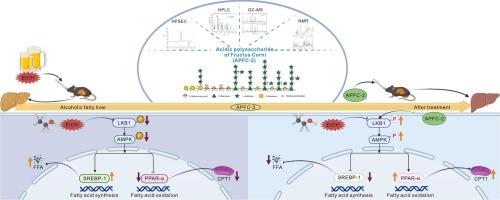山茱萸新型果胶多糖的结构特征及其对酒精性脂肪肝的保护作用。
IF 12.5
1区 化学
Q1 CHEMISTRY, APPLIED
引用次数: 0
摘要
酒精性脂肪性肝病(AFLD)以肝脏脂质积累为特征,目前尚无有效的治疗方法。山茱萸是一种传统的中草药,其提取物具有保护肝脏的作用。我们推测山茱萸多糖可能对AFLD有治疗作用。本研究从山茱萸中分离得到一种新的均相多糖APFC-2 (Mw= 63.0 kDa),并通过单糖组成、甲基化分析、部分酸水解和核磁共振波谱对其结构进行了鉴定。APFC-2果胶多糖,其特征为骨干的T -βgalp -(1→6)βgalp -(1→3、6)βgalp -(1→4)-α-GalpA-OMe -(1→4)-α-GalpA m -(1→]→[2、4)-α世行-(1→4)-α-GalpA -(1→]n,用树枝组成T-Araf -(1→→3)α-Araf -(1→3→5)-α-Araf -(1→→5)α-Araf -(1→。体内实验表明,APFC-2能显著降低AFLD小鼠肝脏脂肪变性、空腹甘油三酯和胆固醇水平。细胞增殖和油红O染色结果显示,APFC-2浓度依赖性地提高了体外细胞活力,显著改善了脂质代谢。机制上,APFC-2通过激活肝激酶B1 (LKB1),进而调控腺苷5′-单磷酸活化蛋白激酶(AMPK)-SREBP-1和AMPK- ppar -α通路,在体外和体内均显著抑制脂质形成。本研究为山茱萸多糖作为LKB1特异性活化剂治疗AFLD的潜在应用提供了理论基础。本文章由计算机程序翻译,如有差异,请以英文原文为准。

Structure characteristics of a novel pectic polysaccharide from Fructus Corni and its protective effect on alcoholic fatty liver
Alcoholic fatty liver disease (AFLD) is characterized by the accumulation of hepatic lipid and has no effective treatment yet. Fructus Corni is a traditional Chinese medicinal herb, and its extractions have demonstrated hepatoprotective properties. We hypothesize that the polysaccharides in Fructus Corni might have therapeutic effects on AFLD. In this study, we isolated a novel homogeneous polysaccharide, APFC-2 (Mw= 63.0 kDa), from the Fructus Corni, and its structure was elucidated by monosaccharide composition, methylation analysis, partial acid hydrolysis, and NMR spectra. APFC-2 is a pectic polysaccharide characterized by a backbone of T-β-Galp-(1 → 6)-β-Galp-(1 → 3,6)-β-Galp-(1 → [4)-α-GalpA-OMe-(1 → 4)-α-GalpA-(1→]m → [2,4)-α-Rhap-(1 → 4)-α-GalpA-(1→]n, with branches comprising T-Araf-(1→, →3)-α-Araf-(1→, →3,5)-α-Araf-(1→, and →5)-α-Araf-(1→. In vivo experiments indicated that APFC-2 could significantly reduce hepatic steatosis, fasting triglyceride, and cholesterol levels in AFLD mice. Cell proliferation and Oil Red O staining results showed that APFC-2 concentration-dependently increased cell viability and significantly improved lipid metabolism in vitro. Mechanistically, APFC-2 markedly inhibited the formation of lipid both in vitro and in vivo through activating liver kinase B1 (LKB1) and then regulating adenosine 5′-monophosphate-activated protein kinase (AMPK)-SREBP-1 and AMPK-PPAR-α pathways. This research provides a theoretical basis for the potential application of Fructus Corni pectic polysaccharide as a specific activator of LKB1 for treating AFLD.
求助全文
通过发布文献求助,成功后即可免费获取论文全文。
去求助
来源期刊

Carbohydrate Polymers
化学-高分子科学
CiteScore
22.40
自引率
8.00%
发文量
1286
审稿时长
47 days
期刊介绍:
Carbohydrate Polymers stands as a prominent journal in the glycoscience field, dedicated to exploring and harnessing the potential of polysaccharides with applications spanning bioenergy, bioplastics, biomaterials, biorefining, chemistry, drug delivery, food, health, nanotechnology, packaging, paper, pharmaceuticals, medicine, oil recovery, textiles, tissue engineering, wood, and various aspects of glycoscience.
The journal emphasizes the central role of well-characterized carbohydrate polymers, highlighting their significance as the primary focus rather than a peripheral topic. Each paper must prominently feature at least one named carbohydrate polymer, evident in both citation and title, with a commitment to innovative research that advances scientific knowledge.
 求助内容:
求助内容: 应助结果提醒方式:
应助结果提醒方式:


